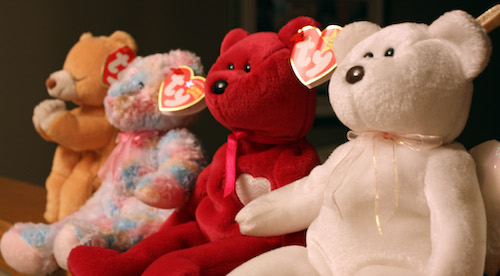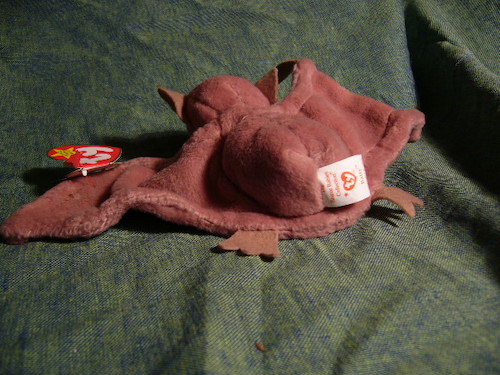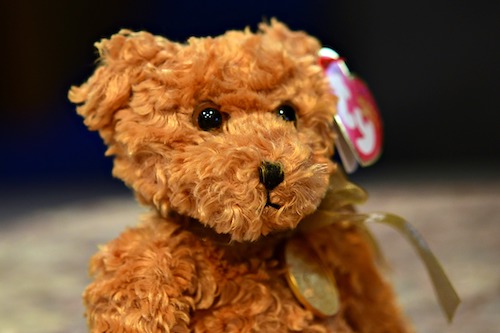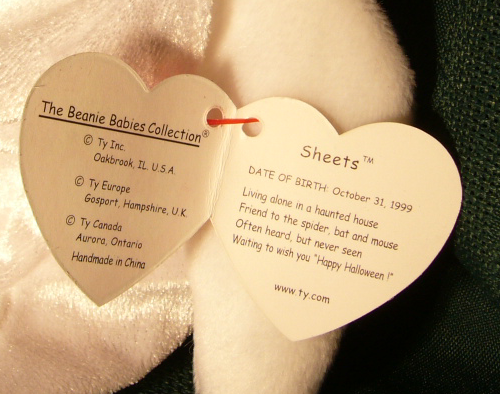Where in the Usa Can I Sell Beanie Babies
Estate sale goers are often on the lookout for plush stuffed beanie babies. Community-based estate sales can often be great places to find beanie babies. These popular sales often contain someone's longtime collectibles.
Sometimes, you come across an entire collection of beanie babies. You might even find several valuable beanie babies. Of course, you snap them right up, because you're looking to sell them for a profit. Now, you'd like some solid tips on pricing these collectible toys.
Beanie Babies' Colorful History
Beanie Babies first appeared on the plush toy market in late 1993, when inventor Ty Warner sold them at New York City's World Toy Fair. Instead of looking like a normal stuffed animal, these little toys contained a mix of stuffing and "beans."
The beans were actually little, plastic, PVC pellets. Together, both kinds of stuffing allowed the beanie babies to pose in different positions. A normal stuffed animal couldn't do that.
Each beanie baby came with a simple first-generation hang tag. Each tag showed a smaller "Ty" imprint on the front, and the backside showed the beanie baby's name and style number. Each beanie baby also had a sewn-in white "tush tag" on its backside.
To keep small children from swallowing the tags, the beanie babies' maker asked owners to remove the tags. So, if you find a first-generation beanie baby with tags, that's quite a rare beanie.
During the 1990s, Ty Warner (later called Ty Inc.) brought out more generations of beanie babies. However, he only sold them in limited quantities. Every so often, Ty Inc. suddenly retired a beanie baby design. This led collectors to buy up lots of beanie babies out of fear they soon wouldn't be available.
Beanie Babies' Underground Economy
Sometimes, shortly after a valuable collectible item hits the market, counterfeit (or fake) duplicates appear on the scene. This was certainly the case with beanie babies, as the first fake collectibles came upon the market in 1997.
Counterfeit Beanie Babies
Counterfeit beanie babies are not to be confused with Beanie Buddies or Mcdonalds' Tennie Beenies. Rather, counterfeits were made to pass for authentic beanie babies. They included toys made to look like Squealer the Pig, a purple Princess Diana bear, and other popular models. One unlucky collector purchased a rare beanie called "Royal Blue Peanut." However, she received a common model that had been colored with cheap-looking blue paint.
Other counterfeit beanie babies had sloppy printed labels, dull-looking eyes, and off-center plastic snouts. Importers sent thousands of fake beanie babies to the American market during the 1990s collecting craze. Because digital photographs weren't the best during that era, a buyer might mistake a fake beanie baby for the real thing.
Beanie Babies Theft
Because beanie babies were very desirable during the 1990s, thieves often stole them from collectors' homes and cars. Clever criminals lifted about 200 beanie babies from a stationery store in March 1999. The fraudsters sold the toys online for huge amounts of money. Retired beanie babies would have brought even more cash.
One larger-scale theft involved a toy distributor who loaded his van with beanie babies and drove to a popular beanie convention. However, the beanies never arrived, as thieves snatched them for use in a stolen goods fencing scheme. Police also made several organized crime busts and found beanie babies on the premises.
Beanie Babies Scams
Beanie baby scams also ran rampant. In Pensacola, Florida, a woman auctioned off rare beanie babies online but didn't send items to buyers after she got paid. One notable grand theft incident involved Chilly the Polar Bear and Nana the Monkey.
Questionable Manufacturer Practices
Beanie baby manufacturer Ty Inc. angered customers and retailers when the company went after knockoff beanie baby producers. Ty Inc. also stopped sending beanie babies to retailers that lowered their prices.
In addition, Ty Inc. told children to report fake online beanie babies. Ty Inc. also worked with officials to catch people returning to the United States with big bags of "special overseas edition" beanie babies to sell for a profit.
The Appeal of Beanie Babies
Right off the bat, beanie babies were a huge hit for several reasons. First, Ty Inc. appealed directly to the kids who would play with the toys, instead of their parents who would buy the little plush animals.
Besides marketing beanie babies directly to children, Ty Inc. offered them as very desirable collectibles. For starters, the company only offered 50 official beanie babies every year, and limited quantities of each design were available. Besides that, individual shops were only allowed to carry a certain number of each beanie baby design.
To create even more demand for beanie babies, Ty Inc. would suddenly retire a beanie baby design with little notice. That led to a buying spree for all the rest of the designs. Buyers just weren't sure when their favorite beanie babies would be pulled from the market.
Together, all of these strategies created a real collecting frenzy. Buyers snapped up the toys like crazy, believing that their little plush animals would increase in value when the design was suddenly retired. From the late 1990s through the early 2000s, that game plan worked. Collectors paid up to 1,000 times more than the original price for rare, retired beanie babies.
Factors Behind Beanie Babies' Popularity
So, what made beanie babies so popular? First, each beanie baby plush animal had a cute name that gave it a personality, like Pinchers the Lobster and Spot the Dog. Each design came with its own colorful biography.
Even better, each beanie baby design was given its own birthday and a story poem. And, beanie babies were very affordable.
The original designs were priced at less than $5 each, which is just about $9 by today's standards.
Buying the beanie babies was part of the fun, as these little plush animals weren't sold in large toy stores. Instead, kids (and their parents) went to small specialty shops to buy the toys. That also increased collectors' interest in beanie babies.
Beanie Babies Generations: Explained
To keep buyers and collectors interested in beanie babies, Ty Inc. kept introducing new "generations" of these popular toys. The first generation came out in 1993 and has always been more valuable than later generations. The end of beanie babies' production came in the early 2000s.
Every generation of beanie babies has the same physical appearance. So, buyers and collectors have to view a specific toy's hang tag to confirm its generation.
Early Design TY Beanie Babies with Good Value
The first-generation beanie babies gathered the most interest, and collectors still value them today. The Original 9 beanie babies were Chocolate the Moose, Flash the Dolphin, and Spot the Dog. First-generation beanies also included Squealer the Pig, Legs the Frog, and Splash the Whale. Brownie the Bear (later called Cubbie the Bear), Patti the Platypus, and Pinchers the Lobster rounded out the group.
Collectors also valued other early design beanie babies. These included Princess the Bear (also called Princess Bear), along with the Curly, Teddy, and Valentino bears. Claude the Crab was also a popular choice. Other desirable beanie babies included Inky the Octopus, Mystic the Unicorn, and Halo the Guardian Angel.
Design quirks made certain beanie babies more valuable. For example, Patti the Platypus came in several colors, which made buyers and collectors want to purchase the complete set. Tie-dyed beanie babies, such as Peace the Bear, were also popular.
Because two tie-dyed items can't be exactly alike; each toy was a one-of-a-kind collectible.
Name discrepancies can also add to the value of beanie babies. For example, there was a typo naming certain lobsters "Punchers" instead of "Pinchers." And Ty Inc. changed "Tabasco the Bull" to "Snort" to avoid a trademark infringement lawsuit, increasing the value of bulls named "Tabasco."
Imitative Beanie Babies
The Beanie Buddies Family
In 1998, Ty Inc. brought out the Beanie Buddies, a larger and cheaper version of beanie babies. The beanie buddies were designed for people who loved beanie babies but didn't want to pay the sky-high prices. However, beanie buddies didn't catch on very well.

McDonalds' Teenie Beanies
Beginning in 1997 and stretching through 2019, McDonalds' Teenie Beanies were included in United States kids' Happy Meals. Over time, these smaller beanies made their way to other countries. Teenie Beanies included Humphrey the Camel, Iggy the Iguana, Steg the Dinosaur, and Erin the Bear (international version).
Four Basic Valuation Guidelines
Before you price your beanie babies, you need to find out more about the collectors' market for them. Learn about the different generations and models. Note the factors that make one beanie baby worth more than a similar model. But before you do your research, take note of these four basic guidelines.
1. Beanie Baby General Classifications
Beanie babies have been divided into two general groups: The Unique/Rare and The Common. Unique and rare models are difficult to locate, as Ty Inc. only made a few thousand of each style. These beanies are very collectible. Unique and Rare beanie babies come from the first, second, and third generations.
On the other hand, common beanie babies were mass-produced, with millions of every style flooding the market. These beanie babies aren't especially collectible. Common beanie babies come from the fourth and later generations.
2. Matching Hang Tag and Tush Tag
First, the hang tag and tush tag must match each other. That means the tags must have the same character name, place of origin, and date. If just one of these items falls short, the beanie baby quickly drops in value.
3. Certificate of Authenticity
If you have a Certificate of Authenticity for your beanie, its value rises instantly. Three well-known beanie baby experts operate "trusted authentication services." These beanie baby gurus closely study each beanie baby you send to them, and they determine if the toy is real or fake. This valuable service helps to ensure that you don't accidentally sell a counterfeit beanie baby, which is against the law.
Make sure the certificate itself is authentic. During the mid-to-late 1990s, some clever counterfeiters even produced their own fake Certificates of Authenticity.
4. Beanie Baby Provenance
Finally, extremely valuable beanie babies must have "provenance," or something that ties the item to a major historical event.
So, beanie babies connected to the Princess Diana Memorial Fund are likely to have increased value.
Or, let's say you can prove that a major 1990s pop star owned a certain beanie baby. That beanie baby will bring a higher value than a similar model owned by a non-celebrity.
Factors That Determine the Beanie's Final Value
To arrive at a beanie baby's final value, ask why the item is desirable. Maybe the beanie baby has a special look or was connected with a specific person or event.
Consider the sale venue. Perhaps the beanie baby model isn't worth much locally but may perform better on eBay or at a collector's auction, compared to a yard sale.
Next, realize that a rare beanie baby will always bring more than a model with thousands of beanies on the market. And be sure you have a real beanie baby and not a knockoff, as various other beanie-looking stuffed toys sprang up during the same period.
Finally, the beanie baby's overall condition is very important. View this guide to "condition" terms:
- Mint Condition: The beanie baby is in "new" condition, and has matching, intact hang tags and tush tags.
- Near Mint: The beanie baby is perfect, but the tags show slight signs of wear.
- Excellent: The plush body is perfect, but the tags may be worn or creased.
- Very Good: The beanie baby is in perfect condition. However, the tags are torn, worn, or completely missing.
- Damaged or Excessively Handled: The fabric is likely worn and/or repaired. The tags may be missing.
Tags
A beanie baby with intact tags will bring a higher price than one without tags. If the toy has a tag error, such as a printing mistake, that increases the value.
Hang Tags
Also called a swing tag, these tags are attached to the beanie baby's ear. The hang tag briefly served as a gift tag.
Tush Tags
A tush tag is attached to the beanie baby's bottom. Tush tags have multiple variations compared to the hang tag. So, identifying a beanie baby just from a tush tag is more difficult.

Stuffing
Sometimes, Ty Inc. understuffed the beanie babies with PVC pellets, as that made them easier to pose. These understuffed beanies are considerably more valued than regularly stuffed ones. However, a collector can tell the difference between an understuffed toy and one whose pellets have merely settled.
Pricing, Listing, and Selling Beanie Babies
The Validity of Price Guides
Finding a good Beanie Babies Price Guide makes pricing your collectibles much easier. Unfortunately, there isn't an official price guide for beanie babies. But there are a few collectibles guides that provide details (including prices) on Ty collectible items. It's just a matter of evaluating the guide's validity.
What a Good Pricing Guide Looks Like
The collectibles market changes very quickly. Some item classes become much more (or less) popular in a single year. In a perfect world, a collectibles price guide would be no more than a year old. This ensures the items' listing and selling prices are recent enough to be useful.
Although there isn't a price guide just for beanie babies, you'll find these collectible toys in varied bean plush guides. A good guide will include current price information and quality photos. Look for details on tags and other important marks.
Why Pricing Guides Can Be Unreliable
Sometimes, a beanie baby price guide's information doesn't match current market conditions. So, you're getting out-of-date information, and you may be less likely to get the results you want.
Some beanie babies collectors post wildly inflated prices when advertising their pieces for sale. Very often, the items sell for much less than the listing prices. Unfortunately, many of those inflated listing prices find their way into the price guides.
Then, other sellers use that flawed data to list their own items.
A price guide with outdated or incorrect information doesn't reflect the most recent beanie babies listing and sale prices. If you go by this information when attempting to sell, potential buyers may think you're out of touch with the market. As a result, they may steer clear of all of your beanie babies listings.
Factors That Influence Price Fluctuations
Two important factors help to determine beanie babies' prices. First, if there are large numbers of a specific design for sale on eBay or other secondary markets, most of those beanies won't be worth much. This "supply and demand" factor is likely to keep most beanie baby prices low.
To find a realistic beanie baby price, average the amount that other buyers have paid for the same model in the last 30-120 days. If a beanie design doesn't show any purchase data for several months, consult a valid Beanie Baby Appraisal Guide.
Listing vs. Selling Prices Analysis
So, what causes the huge difference between beanie babies listing and selling prices? There's a simple reason for this drastic gap.
First, note that mint-condition, first or second-generation beanie babies with original tags have held their value. For example, you might get several hundred dollars for a like-new beanie.
Highly valued beanies such as Princess the Bear have been listed for over $90,000. However, no one has paid more than $90,000 for this little plush toy. So, until you see proof that a buyer actually purchased a beanie at a sky-high price, don't assume the item is worth it.
Establishing Beanie Babies' Value on eBay
Although you'll find thousands of beanie baby eBay listings, many listing prices are highly inflated and unrealistic. So, search for specific items' selling prices in the eBay "Sold Listings" section.
Enter the item details in the search bar, and click "Search." Next, click the "Advanced" prompt to the right of the search bar.
Confirm the details again, and click the "Sold Listings" box.
If you can't find "Sold" prices for a specific design, search for "Sold" prices for similar-generation designs in the same condition.
Current Beanie Babies Market
In 2020, there's a huge glut of beanie babies on the market. Thousands of these little plush toys are sold for pennies on the dollar, while others don't sell at all.
For example, beanies that fetched hundreds (and sometimes thousands) of dollars from 1994 to 1998 are only going for ten cents on the dollar today.
Extremely rare beanie babies, especially those with tag errors or other quirks, still sell on the secondary market. However, prices keep dropping as time goes on.
How to Keep Beanie Babies Saleable
To get the best prices for your beanie babies, take steps to protect them from damage. First, store the beanie babies in a room with low heat and humidity levels. Keep these collectibles away from cold, damp areas, as these conditions could promote mildew on the fabric.
Store Authenticated Items in Plastic Cases
Maybe you've found some authenticated beanie babies in your travels. Each authenticated collectible has a certificate proving that it's the real deal. These beanie babies are generally worth more than your average bear.
If you're lucky enough to own these special beanie babies, store them in sturdy plastic cases. These containers will help protect the beanie baby from environmental damage, and will also keep them out of your pet's reach. Remember that the authentication certificate is key to the beanie baby's value, so keep that paperwork in a safe place.
If your beanies are in great shape, but you don't have authentication paperwork, it's still best to protect these collectibles by placing them in clean, sealable plastic cases or bags.
Minimize Handling
You might be tempted to remove your plush beanie babies from their plastic cases or bags, just to check on them. After you've done that, it's tempting to spend a few minutes touching them. Resist that impulse, as handling them will likely decrease their value.
Keep collectibles away from small children who don't understand the value of these items. Some good-intentioned playtime could end in lowering the value of your beanie.
Avoid Crushing or Damaging Items
Maybe your home's storage space is limited, so you've added your beanie babies to an already-full storage area. Do this with caution. Placing your beanie babies where they can be crushed or otherwise damaged could result in the destruction of your once-valuable item. If that occurs, you'll have a very hard time selling them.
Where in the Usa Can I Sell Beanie Babies
Source: https://www.truelegacyhomes.com/beanie-baby-appraisal/


0 Response to "Where in the Usa Can I Sell Beanie Babies"
Post a Comment